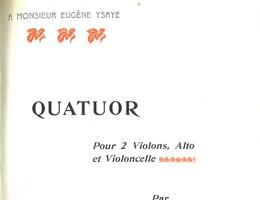String Quartet no. 1 in D minor op. 112
Allegro. Più allegro – Molto allegro quasi presto – Molto adagio – Allegro non troppo. Molto allegro.
“If I hadn’t written this quartet,” wrote Saint-Saëns to his publisher, “the aestheticians would have drawn all kinds of conclusions from this omission, and they would have found what it was in my nature that had stopped me from writing one and why I was incapable of writing one! Have no doubt about it, I know what they’re like. And all the while I had not accomplished this necessary task, I was afraid of passing away too soon, I could not rest easy. Now I don’t care about any of it”. Eugène Ysaÿe, the quartet’s dedicatee, and perhaps the person who instigated it, gave the first performance at the Concerts Colonne on 21 December 1899. Saint-Saëns was 64 at the time; having put the boldness of youth behind him, he was a self-professed guardian of tradition. One might therefore expect an authoritative, dogmatic and polished work. However, this quartet is striking for its unexpected formal treatment, the mobility of the motifs (running counter to the popularity for cyclic themes) and the deliberately orchestral, at times impressionistic, handling of the quartet (mutes, tremolos, percussion) to the detriment of the polyphonic ideal and the Beethovenian model of equality between sections, given that the first violin part is so often dominant. The continually lucid harmonic language is rich in fleeting ambiguities and a world away from post-Wagnerian chromatic complications. The most remarkable feature is the active fluidity of the fragmentary contrapuntal writing in which cells or lines meet and mesh to form a fretwork of different sounds.

